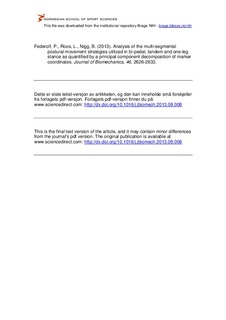| dc.contributor.author | Federolf, Peter | |
| dc.contributor.author | Roos, Lillian | |
| dc.contributor.author | Nigg, Benno | |
| dc.date.accessioned | 2013-11-08T12:50:48Z | |
| dc.date.available | 2013-11-08T12:50:48Z | |
| dc.date.issued | 2013-10-18 | |
| dc.identifier | Seksjon for fysisk prestasjonsevne / Department of Physical Performance | |
| dc.identifier.citation | Journal of Biomechanics. 2013, 46, 2626-2633 | no_NO |
| dc.identifier.uri | http://hdl.handle.net/11250/171178 | |
| dc.description | I Brage finner du siste tekst-versjon av artikkelen, og den kan inneholde ubetydelige forskjeller fra forlagets pdf-versjon. Forlagets pdf-versjon finner du på www.sciencedirect.com: http://dx.doi.org/10.1016/j.jbiomech.2013.08.008 / In Brage you'll find the final text version of the article, and it may contain insignificant differences from the journal's pdf version. The definitive version is available at www.sciencedirect.com: http://dx.doi.org/10.1016/j.jbiomech.2013.08.008 | no_NO |
| dc.description.abstract | Postural control research describes ankle-, hip-, or multi-joint strategies as mechanisms to control upright posture. The objectives of this study were, first, development of an analysis technique facilitating a direct comparison of the structure of such multi-segment postural movement patterns between subjects; second, comparison of the complexity of postural movements between three stances of different difficulty levels; and third, investigation of between-subject differences in the structure of postural movements and of factors that may contribute to these differences.
Twenty-nine subjects completed 100-s trials in bipedal (BP), tandem (TA) and one-leg stance (OL). Their postural movements were recorded using 28 reflective markers distributed over all body segments. These marker coordinates were interpreted as 84-dimensional posture vectors, normalized, concatenated from all subjects, and submitted to a principal component analysis (PCA) to extract principal movement components (PMs). The PMs were characterized by determining their relative contribution to the subject's entire postural movements and the smoothness of their time series.
Four, eight, and nine PM were needed to represent 90% of the total variance in BP, TA, and OL, respectively, suggesting that increased task difficulty is associated with increased complexity of the movement structure. Different subjects utilized different combinations of PMs to control their posture. In several PMs, the relative contribution of a PM to a subject's overall postural movements correlated with the smoothness of the PM's time series, suggesting that utilization of specific postural PMs may depend on the subject's ability to control the PM's temporal evolution. | no_NO |
| dc.language.iso | eng | no_NO |
| dc.publisher | Elsevier | no_NO |
| dc.subject | coordination of movements | no_NO |
| dc.subject | movement synergies | no_NO |
| dc.subject | postural control strategy | no_NO |
| dc.subject | balance and stability | no_NO |
| dc.subject | upright quiet stance | no_NO |
| dc.subject | locomotor system | no_NO |
| dc.subject | principal component analysis (PCA) | no_NO |
| dc.title | Analysis of the multi-segmental postural movement strategies utilized in bipedal, tandem and one-leg stance as quantified by a principal component decomposition of marker coordinates | no_NO |
| dc.type | Journal article | no_NO |
| dc.type | Peer reviewed | no_NO |
| dc.subject.nsi | VDP::Technology: 500 | no_NO |
| dc.source.journal | Journal of Biomechanics | no_NO |
| dc.identifier.doi | 10.1016/j.jbiomech.2013.08.008 | |
